A Complete Guide to First-Party Data: The Solution to a Cookieless World
Published on March 13, 2024/Last edited on March 13, 2024/13 min read
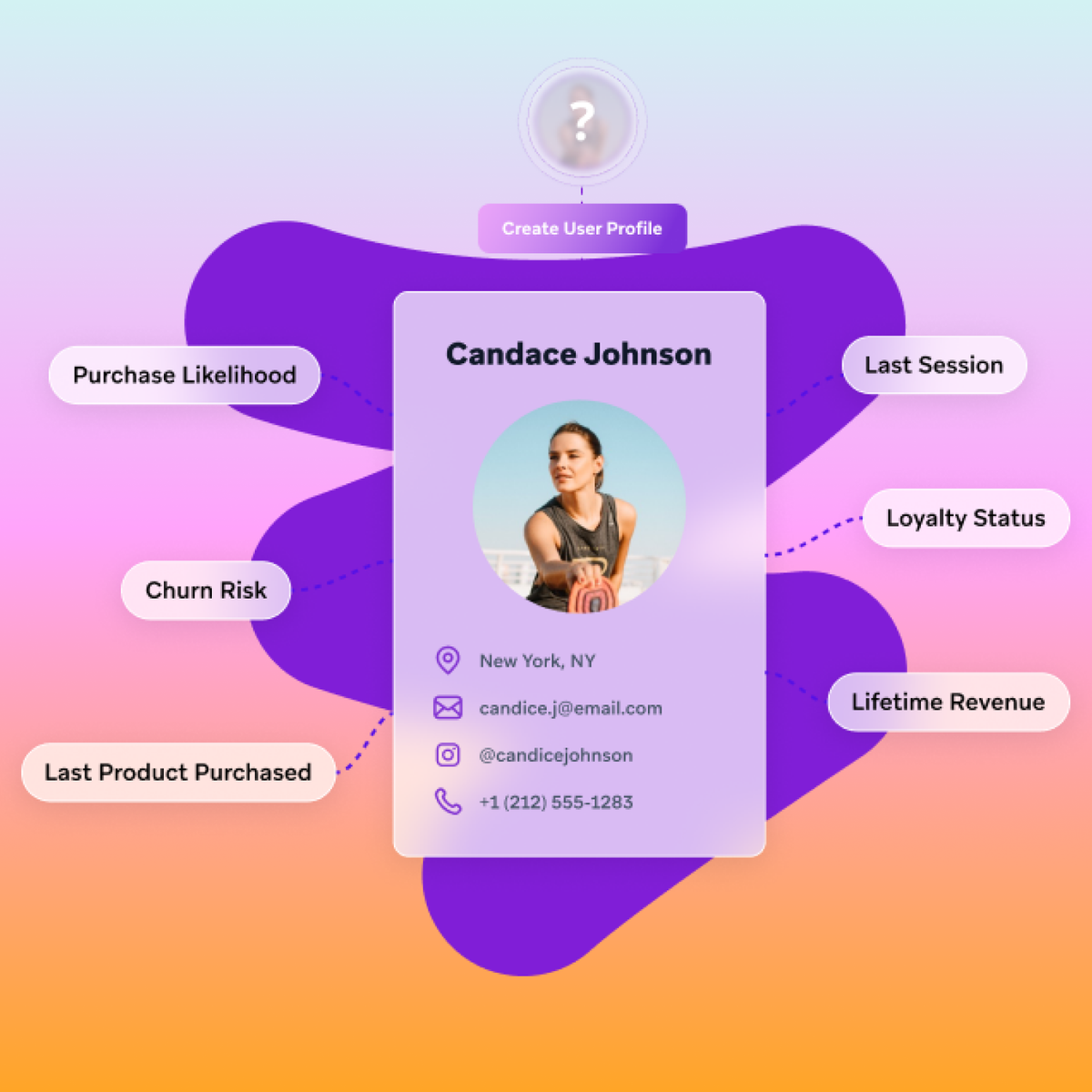

Team Braze
Cookies. Those loveable little pieces of information that are sent to your browser by the websites you visit. They do things like identify who you are, remember your choices, and note what you’ve clicked on and what items you’ve added to your shopping cart. Cookies also remember what website you came from and where you went next. Historically, marketers have utilized cookies because they provide copious amounts of third-party data. In other words, data not owned by the marketer, but that can be used to build a picture of each customer to whom they can target digital advertisements. Cookies can increase personalization and create a more seamless experience online.
So as third-party cookies are being phased out, and the final switch-offs approach completion, marketers may be left thinking, where does this leave us?
As cookies are phased out, businesses need to rely more fully on first-party data. So let’s find out what that means and what lies ahead in a cookieless world.
- What is first-party data?
- Why Is first-party data important?
- What’s the difference between zero-party data, first-party data, second-party data, and third-party data?
- 3 compliant, effective ways to use first-party data
- 5 real-life examples of campaigns leveraging first-party data
- How a customer engagement platform can support first-party data
- Final thoughts
- First-party data FAQs
- Featured first-party data resources
What is first-party data?
First-party data is directly owned by a brand, as it comes directly from their customers and audience, with users’ express consent. There is no other party involved in collecting this information; your business is the first to ask for it directly in relation to your business, hence why it’s called “first-party.”
First-party data can include things like:
- Demographics
- Purchase history
- Subscriptions
- Email engagement
- Social media followers
- How often someone visits your website or app
- …and more
Why is first-party data important?
First-party data is important because it’s reliable, accurate, and ethical. While organizations that rely heavily on third-party data may see the removal of cookies as creating a gap they now need to fill, this gap was always there. Third-party data was convenient, but it was never ideal in terms of truly understanding your customers.
First-party data forges stronger connections with consumers and as Google themselves have stated, “helps brands to build direct relationships with their customers, create value, and boost their advertising performance.” Google also found that those using first-party data for key marketing functions achieved up to 2.9X revenue uplift and a 1.5X increase in cost savings.
What’s the difference between first-party data, second-party data, third-party data, and zero-party data?
The differences between types of data can be confusing, so let’s go through each of them.
What is first-party data?
First-party data is information collected by an organization, directly from its audience, with each user’s consent. This data can be shared directly or indirectly through any of a brand’s owned digital experiences and is activity-based. Consider this example: A brand sends a customer an email, the customer opens that email and clicks on a link within the email. That use and behavior is tracked by the brand and is considered first-party data because the customer had opted into receiving brand emails.
What is second-party data?
Second-party data is another organization’s first-party data. It is shared between trusted partners as a way to leverage customer insights and see how they are interacting with other brands. Second-party data includes email subscribers, customer feedback, surveys, and social media profiles. These can be used by one brand to target another brand’s audience that is similar to their own. In general, it only makes sense to leverage second-party data if the users whose information is being shared have been notified about the arrangement and given the option to opt out; otherwise, you run the risk of messaging users who actively do not want to hear from you.
What is third-party data?
Third-party data is any information collected by another organization that has no link to your own. It is often captured without the consent of the consumer and therefore it can be unreliable and inaccurate. Beyond advertising cookies, data aggregators pay other companies for their first-party data, collect it all into one set and then sell it as third-party data. It’s usually bought and sold on a mass scale with thousands and thousands of data points, which are used to make inferences about a user’s lifestyle, create profiles, and then predictions that are sold to advertisers and used for targeting personalized ads.
This type of data is widely available, which means your competitors can buy it, too. More importantly, with the phase-out of third-party cookies, a large chunk of this third-party data will no longer exist, so it’s important your strategies are focused on better data for a wide variety of reasons.
What is zero-party data?
Zero-party data, like first-party data, comes directly from the audience with their consent. It differs from first-party, however, in that it is collected via direct customer communication through surveys, polls, and feedback, as opposed to web and transactional behaviors. Zero-party data can be useful in learning what customers really think of your brand, in their own words. It can validate and support other data or it can highlight differences. Zero-party data can also help flesh out anonymous and guest users, who account for 86% of retail users and 57% of users across all brands—a huge untapped audience.
3 compliant, effective ways to use first-party data
Balancing privacy and personalization takes a thoughtful approach. Here are three ways you can use first-party data in an effective and compliant way.
Free trial opt-ins
If you want to convert anonymous users who are actively browsing your website, offering a free trial to your company’s subscription service is one way to do it. By testing a variety of channels, content and design options as well as message send times you’ll be able to find the best time and options to maximize conversion rate. Once users opt in, you not only have access to first-party data, but they’ll be more likely to commit to becoming paid customers too.
Abandoned onboarding
Maybe someone has created an account but not completed their profile. Maybe they’ve subscribed to your newsletter with their email address but haven’t given any more details. They’ve been introduced to your brand but they aren’t getting the full benefits of your app or website because they aren’t fully engaged and you are unable to send them more personalized messages.
Using email, mobile push, and web push notifications, you can re-engage these users and show them the value of picking up where they left off. In completing their profile, adding a payment method, or choosing preferences—whatever it is you would like them to do—you can deep link them directly to the next step, providing a clear and easy path to completion.
Order tracking
If a customer places an order from you and can’t easily access their order status, your customer service team will take the hit. To keep customers informed, you can send automated messages that are enriched and triggered by first-party data from your internal systems. Customers will be updated as their order moves through each stage of the delivery process.
5 real-life examples of campaigns leveraging first-party data
The following five examples show how first-party data can be leveraged in marketing campaigns with huge success.
Payomatic
Payomatic is a New York-based check cashing and financial services provider. They took a new approach to their marketing strategy to increase personalization by leveraging the wealth of first-party data at their disposal.
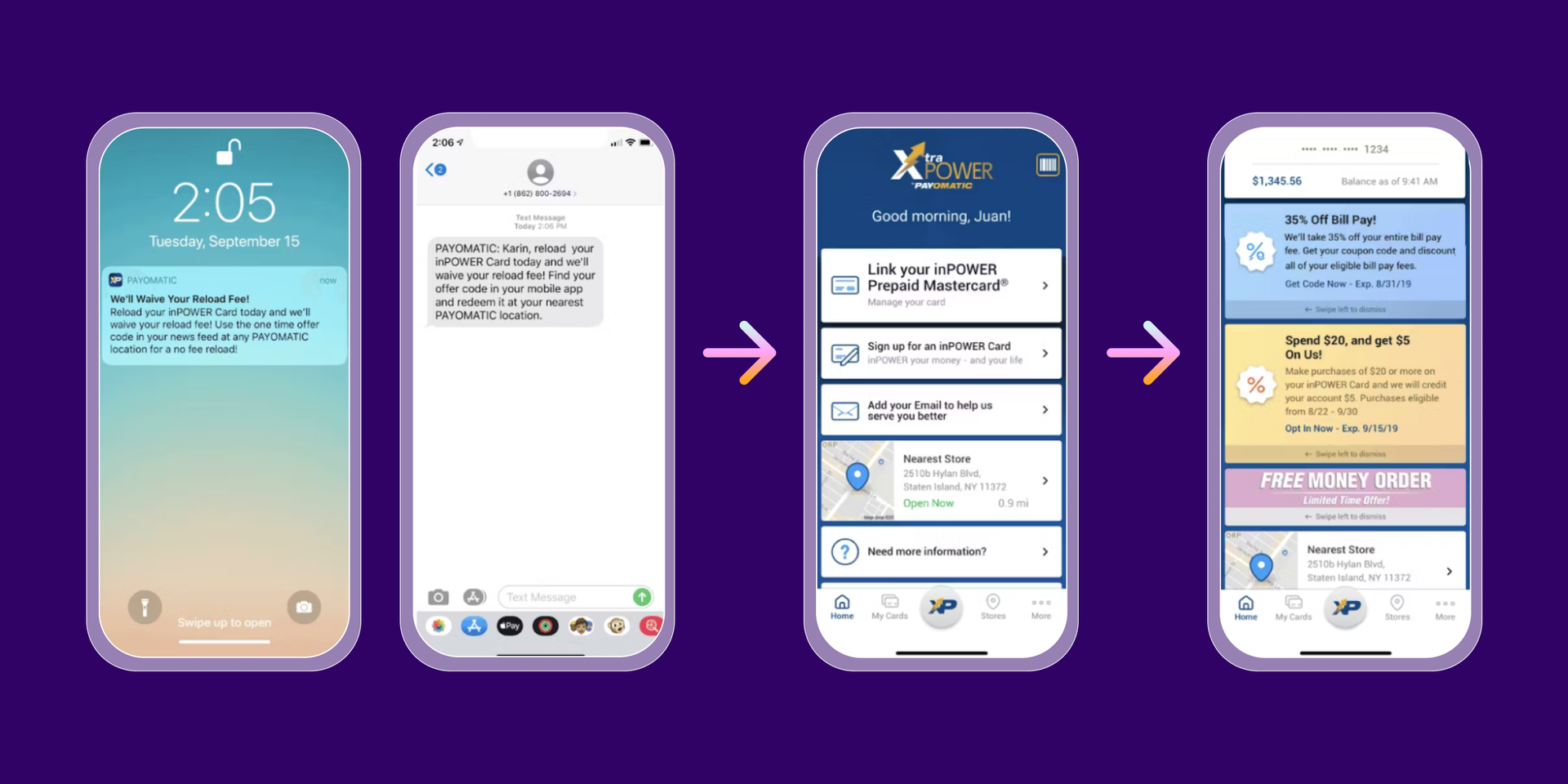
Problem
Payomatic wanted to evolve its traditional brick-and-mortar business model to go digital. They chose to add cross-channel, 1:1 customer engagement capabilities to improve existing marketing efforts and to support this digital transformation.
Strategy
Payomatic used Braze to reach out to customers encouraging them to engage in high-value activities, such as reloading prepaid cards and sending money to family and friends. With push notifications, in-app messages, Content Cards, and Connected Content, they were able to guide customers through a journey, send personalized messages, and offer codes while avoiding the usual data management headaches because they had a unified view of all their data.
Results
- A 32% uplift in direct deposit adoption via the app.
- 11% increase in mobile app engagement.
- 50% prepaid cardholder mobile app penetration.
Tapas
Tapas Entertainment is a fast-growing digital publishing platform for webcomics and novels with over 9 million monthly active users. It hosts content from over 68,000 creators.
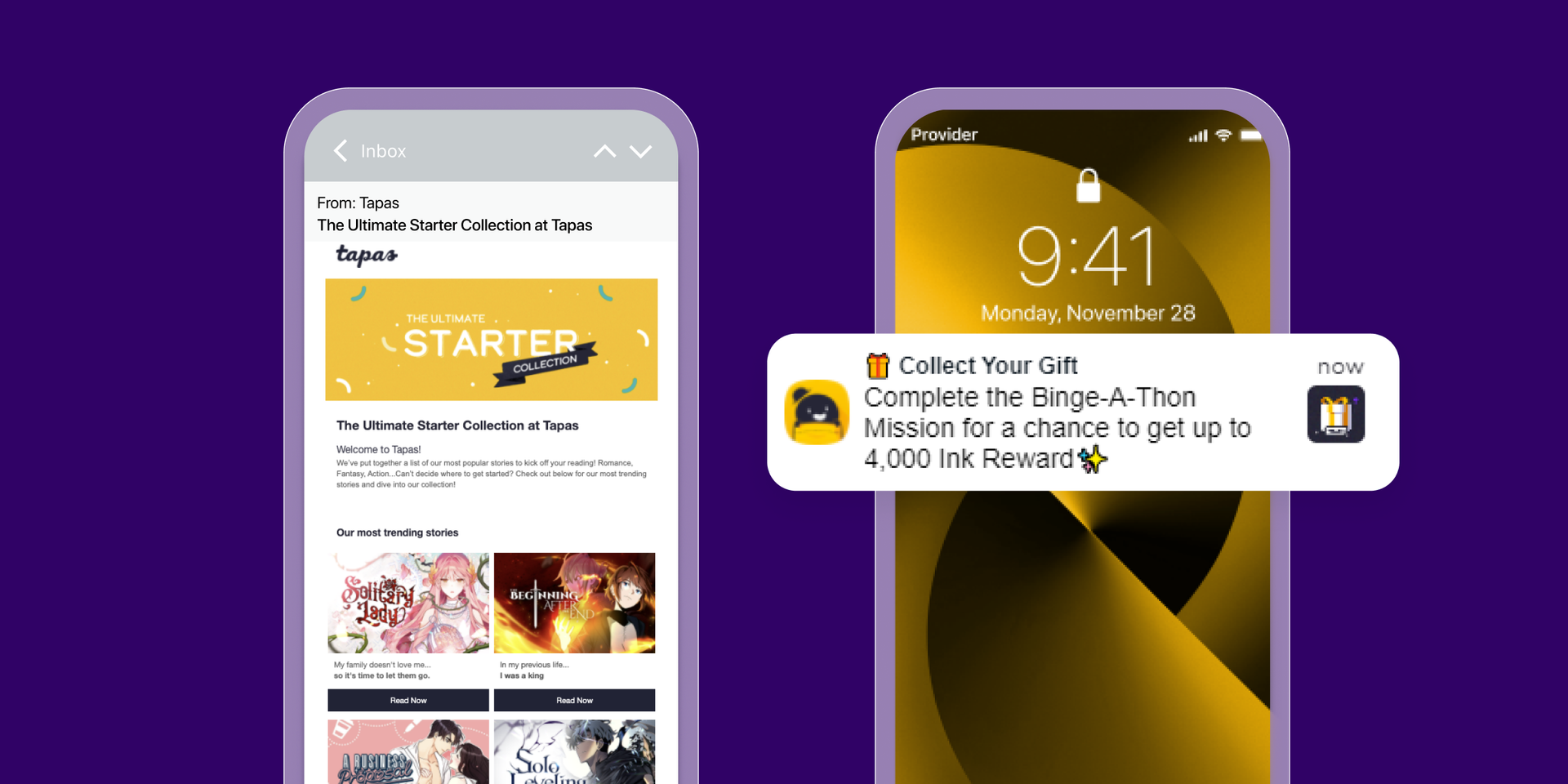
Problem
Tapas was struggling with measuring onboarding data. They found it difficult to track information, their data was in silos, and there were gaps in their first-party data. All of this made it a challenge to send out relevant and personalized messages. They came to Braze wanting to boost user retention and leverage data so they could make more informed and strategic decisions.
Strategy
Tapas operates on a freemium model, with the option to unlock more content by purchasing their own form of currency, “Ink.” This is their most important source of revenue, so it was important to capture the attention of the reader and encourage them to take action to become a paid user. By leveraging Braze Canvas, Tapas was able to create a personalized experience based on user behavior and, with this first-party data, could send push notifications to recommend relevant content to each person.
Tracking was improved and the marketing team developed tests. By looking at conversion data, this continual A/B testing has created outstanding results.
Results
- 100% increase in new user retention.
- 28% increase in “Ink” purchases.
- 10% increase in episode read funnel.
Burger King
Fast food giant Burger King is well-known for its innovative marketing campaigns and is always looking for ways to improve. They identified an opportunity to better segment their customers so that they could send more personalized, relevant, and value-driven messages.
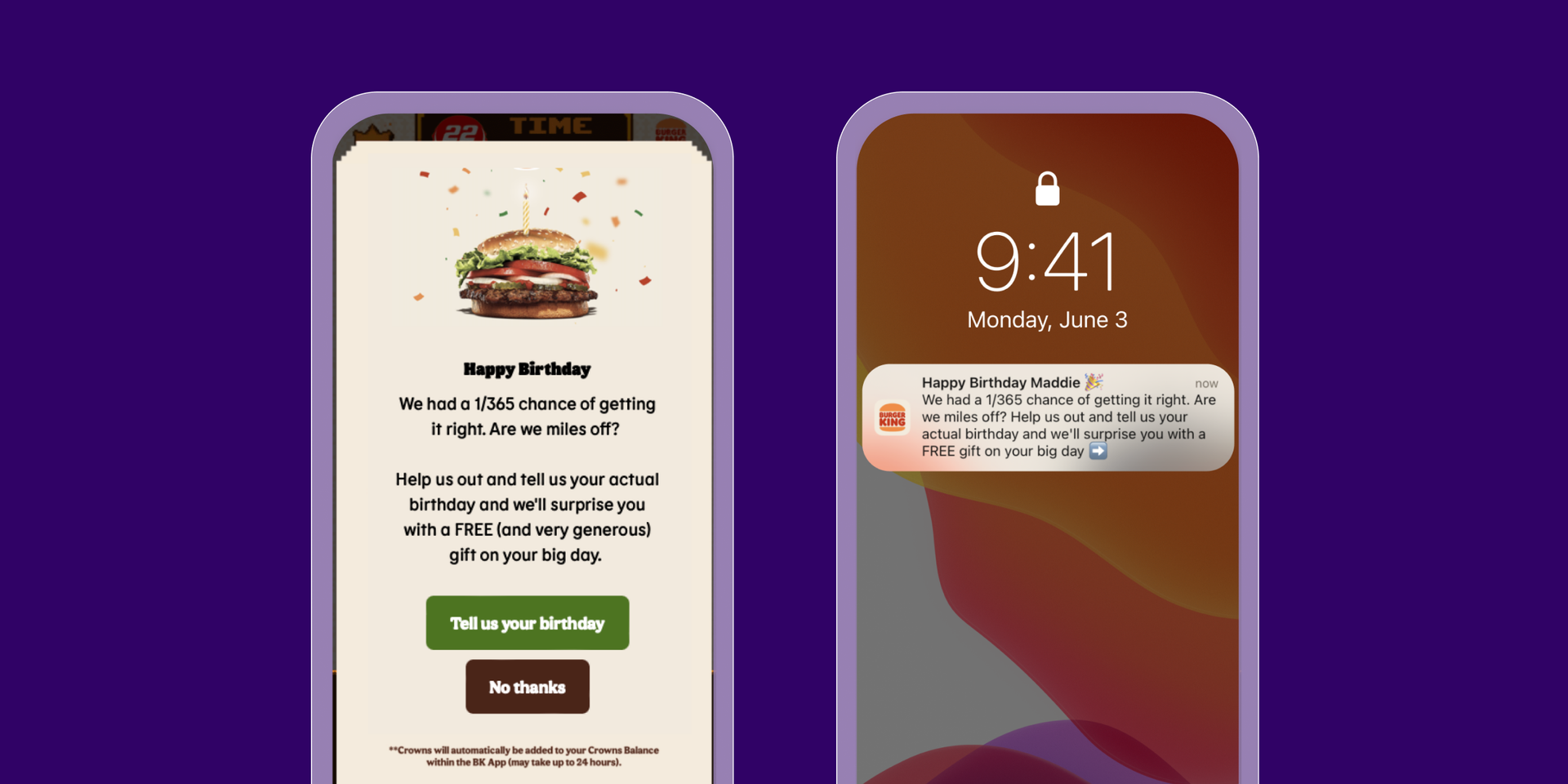
Problem
Burger King UK launched a birthday discount program and noticed that many users weren’t inputting their date of birth within the app. This meant there were fewer opportunities to offer birthday discounts and customized messaging based on age ranges.
Strategy
With the help of Braze and real-time first-party data, they quickly created a personalized, cross-channel messaging campaign designed to persuade users to self-report their birthday in exchange for a special deal on their big day, thereby gaining zero-party data. Emails, push notifications, and in-app messages were sent just before peak app usage time.
Results
- 70,000 more customers navigated to the app to update their birthday, which represents 15% of total birth dates in their customer database.
- An 800% increase in the daily number of users self-reporting their date of birth.
- 60% of those who gave their birthday then went on to browse the menu or offer pages in the app.
- A 55% direct open rate.
- A 22% click-to-open rate.
- A 10% click-through rate (CTR).
Max (Formerly HBO Max)
Max is a direct-to-consumer streaming platform from the Warner Bros. Discovery family. They are always looking for valuable and memorable ways to engage their users and have created everything from personalized recommendations to fun quizzes.
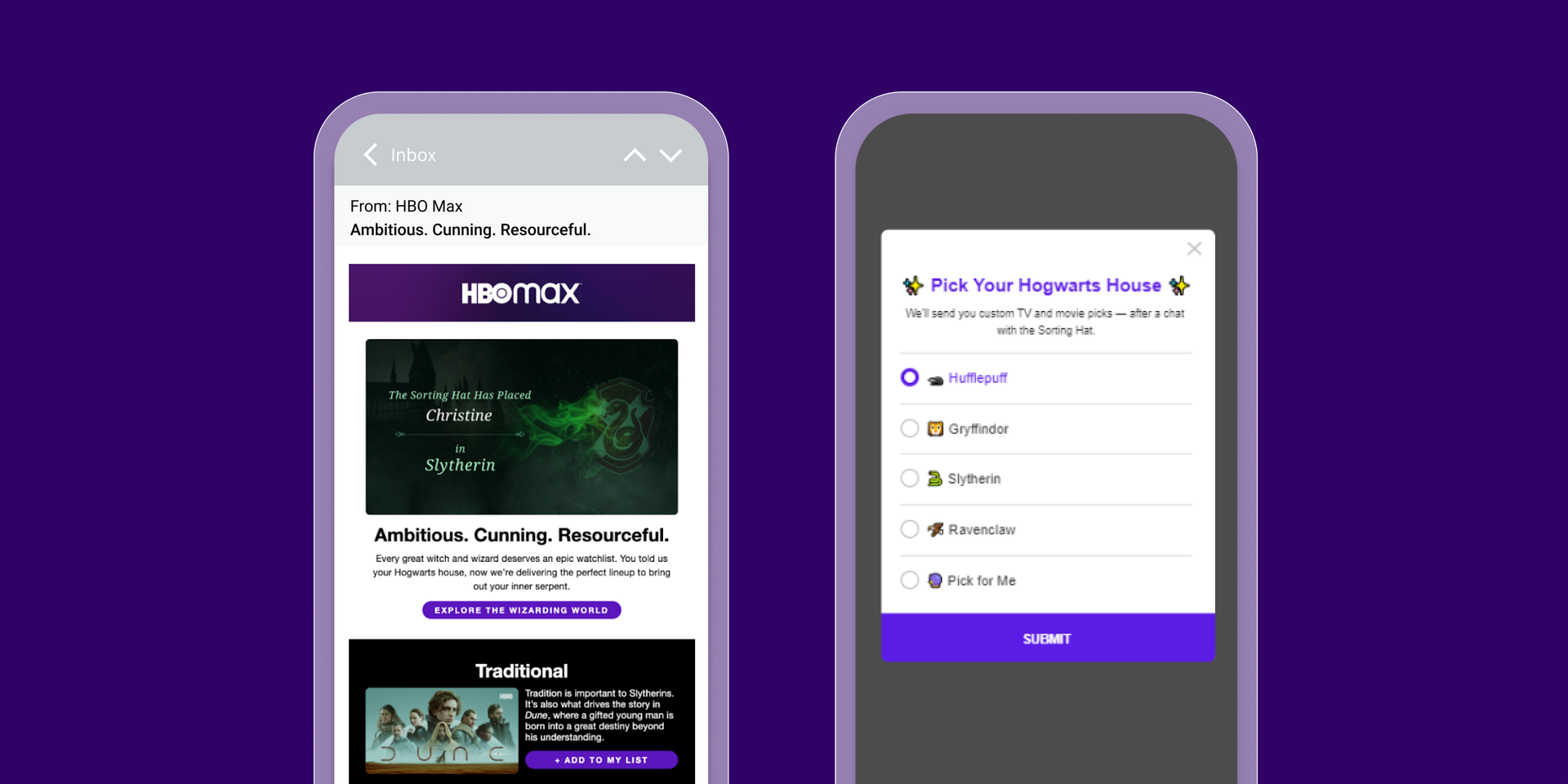
Problem
Max wanted to create a buzz around the new Fantastic Beast films so they developed a customized survey based on viewers’ preferences and history.
Strategy
Using Braze Canvas they created a personalized messaging flow. It began with a simple one question survey asking users to choose their Hogwarts House, which gained zero-party data. The user’s answer would then trigger the messaging flow and users would receive an email if they fit certain criteria for consent. If they didn't, a push notification was sent to encourage the user to opt in. The messaging was surrounded in story, with images featuring the user’s house crest and own name, and recommendations on other titles to watch. It tapped into the emotional core of being a Harry Potter fan and produced exceptional results.
Results
- A 3.36% lift in viewership of the featured recommended titles.
- A 3.12% lift in session starts.
- A 6X higher click rate to the in-app message.
How a customer engagement platform can support first-party data
The importance of building a marketing tech stack that can serve your audience well—enabling you to send relevant messages, on the right channels,in the right way, at the right time—cannot be overstated. With that said, you also need a data ecosystem that, at every layer, complies with changing privacy regulations and transfers information in real-time for the most agile applications.
Braze helps support this data agility by providing a unified view of the customer, offering real-time data analytics, and integrating with emerging technologies, including AI. Additionally, Braze helps marketers stay on top of new regulations, best practices, and data privacy laws, with access to data management and data export capabilities to get the information needed from throughout user journeys and quickly merge this into your brand’s personalized and dynamic messaging strategy.
The Braze platform excels at making information easily accessible. You can collect, unify, and activate any amount of data from any source, without friction or unnecessary processes or technologies. Integration is flexible and the platform helps you to build a holistic view of each customer. You can take action on your data in Braze instantaneously, without needing support from technical resources. Your data is safe, secure, and compliant too, so you can build stronger relationships with customers, via relevant and impactful messaging.
Final thoughts
While the changes to cookies and third-party data may seem daunting, the changes ahead are a reminder of the importance of first-party data—and the opportunity to enhance the level of personalization you deliver to customers, to drive increased loyalty and customer retention. When combining your marketing expertise with reliable data and a flexible technology platform, you can further elevate consumer engagement to become the heartbeat of positive and trusting relationship between consumers and yourbrand.
For more insights on leveraging real-time customer data, our guide on Minimum Viable Data is a must-read and goes into more depth on how to balance personalization and privacy.
First-party data FAQs
Does GDPR apply to first-party data?
Yes, GDPR and other privacy laws and regulations do apply to first-party data. First-party data is regarded as the safer choice because it is collected with consent, direct from the consumer.
What are the limitations of first-party data?
The primary limitation around first-party data is that it only includes data from your existing customers or those who have directly interacted with your business. It does not include data from similar audiences or potential customers.
How do I capture first-party data?
First-party data can be collected from any digital experience that you own. Your website, apps, analytics and social media. It can be collected through emails, push notifications, interactions, and behavior. To capture and analyze this data effectively, you need a marketing tech stack and a customer engagement platform.
Can first-party data be anonymous?
Yes. As an example, 86% of retail users are anonymous. These users can complete the checkout process on websites as guests, browse a website but not purchase anything or sign up for emails with just their email address. In these instances, you have limited information about them so they are classed as anonymous. But there are engagement campaigns you can run to help learn more about these users and turn them from anonymous to known.
Featured first-party data resources
Related Tags
Releated Content
View the Blog
Enterprise generative AI: Transforming data, decisions, and customer experiences

Team Braze
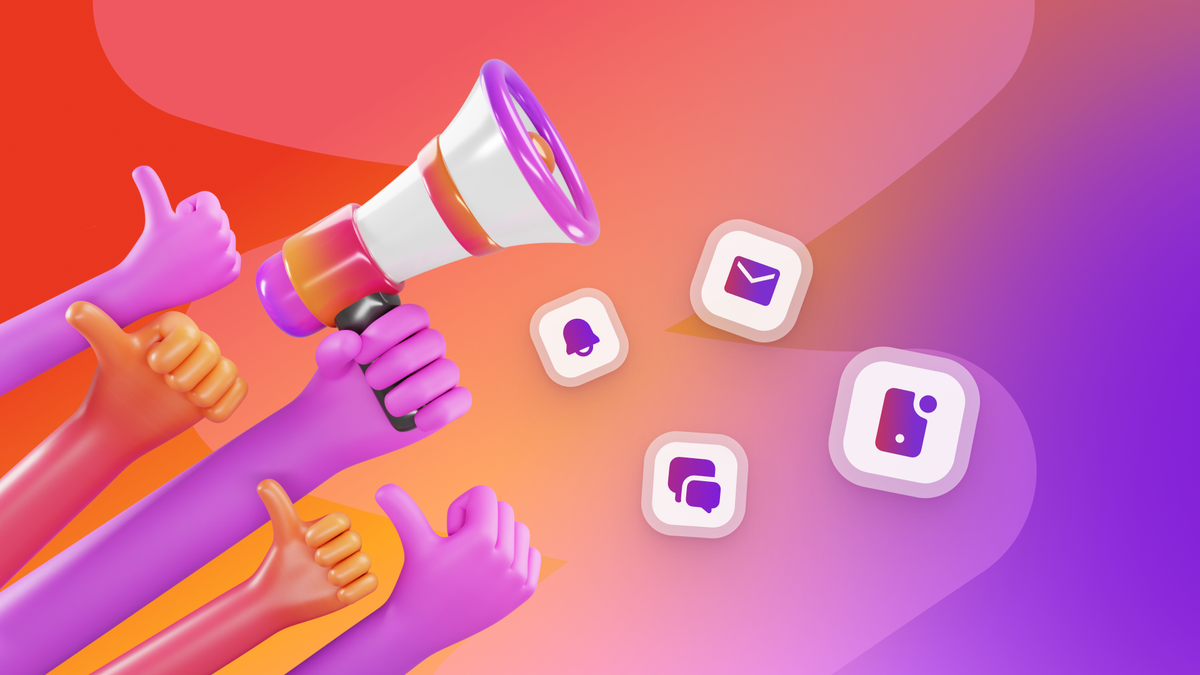
Omnichannel personalization: Delivering consistent, connected customer experiences

Team Braze

Are you AI-savvy enough to survive? A wake-up call for CMOs
